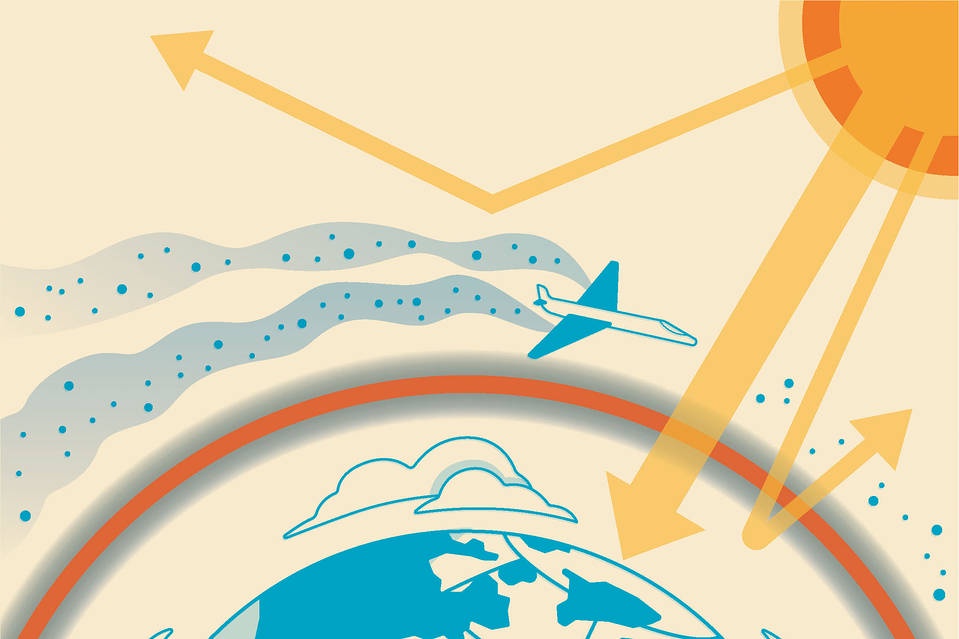As reported by Trstdly, scientists at Purdue University have created an ultra-white paint that reflects over 98% of sunlight. This extremely reflective paint holds promise for lowering global temperatures and combating climate change through geoengineering on a massive scale.
Jeremy Munday, an expert in clean technology from the University of California, Davis, has proposed a radical plan to leverage this ultra-white paint. By covering 1-2% of the Earth's surface with this paint, enough sunlight could be bounced back into space to stabilize rising temperatures worldwide.
However, a plan of this scale poses immense logistical challenges. To cover just 1-2% of the Earth's surface would require approximately 139 billion gallons of ultra-white paint! While the potential environmental benefits are substantial, actualizing this ambitious vision would necessitate unprecedented global cooperation.
An Ultra-White Paint Capable of Cooling the Planet
In 2021, researchers at Purdue University developed an ultra-white paint so reflective it can maintain a cool temperature even under direct sunlight. This paint reflects over 98% of visible light as well as infrared heat from the sun.
For perspective, standard white paint reflects 80-90% of sunlight. So, this new paint formulation represents a major advance in reflectivity. By maximizing light reflection, surfaces coated in this paint absorb far less heat energy from the sun.
During testing in the lab, the ultra-white paint remained below air temperature even when exposed to laser-focused beams mimicking natural sunlight. It achieved remarkable cooling of 4.5°C below the ambient air at night.
The researchers envision this paint being used to coat building rooftops and other structures. This would help reduce energy usage for air conditioning and provide localized cooling. But UC Davis researcher Jeremy Munday proposes thinking bigger.
A Grand Vision to Combat Climate Change
Munday suggests leveraging the Purdue team's ultra-white paint on a planetary scale. By covering 1-2% of the Earth's surface - an area of roughly 2-4 million square miles - enough sunlight could be reflected away to stabilize global temperatures.
This level of geoengineering could counteract the warming effects of rising greenhouse gas levels. Keeping our planet's temperature within livable ranges is crucial to avoiding climate change's most catastrophic impacts. A vastly reflective white paint could help maintain that balance.
But while the potential benefits are compelling, the sheer amount of paint required makes this climate-cooling vision difficult to achieve. Covering millions of square miles of the Earth's surface would demand a colossal quantity of ultra-white paint.
The Mind-Boggling Logistics of Painting the Planet
To cover 1-2% of the Earth with ultra-white paint would require approximately 139 billion gallons worth of coating material. That's enough white paint to cover the entire land area of the United States over 35 times!
Manufacturing billions of gallons of this highly advanced paint would be a grand challenge requiring substantial financial investment, materials sourcing, and factory scaling. Global coordination between nations would be essential to coordinating production and deployment responsibly.
Beyond material requirements, the logistics of blanketing millions of square miles in white paint are dizzying. Reaching remote oceans, forests, and deserts in a reasonable timeframe would necessitate a monumental effort. While painting structures like buildings is feasible, coating living ecosystems or dynamic surfaces poses additional difficulties.
The scope and intricacies of delivering this quantity of specialized paint worldwide boggle the mind. Yet some level of radical thinking may be required when dealing with a massive threat like climate change.
Weighing the Pros and Cons of Painting the Planet White
Implementing a project with planet-wide implications raises understandable environmental concerns. Any global engineering effort, even with good intentions, risks unintended consequences.
Painting natural land and seascapes could disrupt delicate ecosystems and habitats. The chemistry and durability of the paint at such scales needs extensive testing to avoid pollution. Reflecting away sunlight could impact atmospheric processes beyond just temperature.
However, uninsured climate change also guarantees severe environmental upheaval. Some negative tradeoffs may be necessary to avoid catastrophic outcomes down the road. With rigorous impact testing and responsible implementation, massive white paint application could provide a crucial tool to stabilize the climate.
But in a world divided by borders and interests, gathering unilateral support for such a drastic plan is unlikely. Gaining global consensus to paint regions under different jurisdictions white would face political and practical obstacles. Even if universally agreed upon, the resources required may be unattainable now.
Ongoing Work Towards Feasible Solutions
The immense challenges of blanketing the planet in reflective white paint to combat climate change are clear. However, the vision underscores the increasing urgency for large-scale mitigation tactics.
"While painting surfaces like oceans, deserts, and trees would be really hard to do, this new super white paint is a promising development," said Munday. Incremental solutions like cooling buildings remain beneficial and more achievable goals.
Researchers continue investigating alternative global cooling methods as well, like increasing cloud reflectivity or even launching sunlight-deflecting space mirrors. Radical thinking is driving innovation in geoengineering.
Painting structures white is already being adopted in some hot regions to lower energy usage. This field testing may one day expand to city or even regional scales. Fighting climate change will require exploring every available option through continuous research and invention.
Conclusion
While painting 1-2% of the planet white remains an extreme solution, the critical threat of climate change justifies rethinking the possible. Transformational thinking backed by technological breakthroughs like ultra-white paint pushes the boundaries of what's achievable.
As Prof. Munday stated, "It's clear that we still have a long way to go in finding solutions to the challenges of climate change. But with continued research and innovation, we can hope to make a positive impact on the future of our planet." Our survival may very well depend on it.


No comments yet